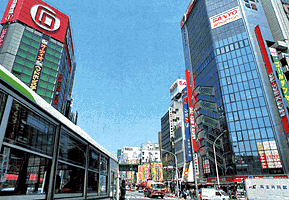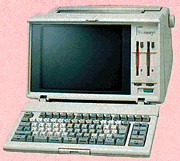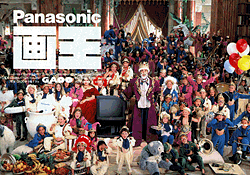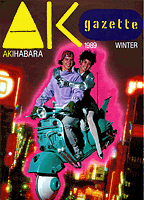Chapter 6-The rise and fall of the bubble economy, and the arrival of a multimedia society (1985-1996)-

Akihabara seen from Chuo-dori in 1990
Overcoming the energy crisis of the Showa 50s, which was triggered by the oil crisis of 1973, the Japanese economy and the world economy were entering a new paradigm.
With the development of telecommunications, the world economy has influenced each other through exchange rates and securities markets, and Japan has entered an era in which it has no choice but to live with changes in the world.
On the surface, Japan has repeated an unprecedented boom and bust with the appreciation of the yen, the rise and fall of the bubble economy, but on the other hand, in 10 years when the transformation into a multimedia society has steadily progressed. there were.
Akihabara has also undergone unprecedented change as the forefront of that change.
Japan as a whole / Home appliances market in the Showa 60s (economy)
 |
| 1989 / NEC / Bungo MINI 7R / 198,000 yen (excluding tax) |
From the latter half of the Showa 50s, the material industry such as petrochemicals and steel, which was the center of the industry during the period of high economic growth, rapidly increased due to rising energy costs, declining demand due to the promotion of energy conservation, and the catch-up of developing countries. With the decline, the processing industry centered on electronics or the software industry has emerged.
Advances in semiconductor technology have dramatically improved the degree of integration of ICs (integrated circuits), and the miniaturization has progressed rapidly and the prices have become cheaper.The IC technology has made machine tools high performance in the industrial sector. With the advent of NC machine tools, industrial robots, CAD / CAM, etc., it brought about a major revolution in factories, and improved processing accuracy, energy saving, labor saving, and rationalization of production processes.
In addition, office automation has progressed in the office department, and the introduction of word processors, personal computers, and facsimiles has progressed rapidly, labor saving and rationalization of office work have been promoted.
In this way, Japan, which was undergoing a transformation of its industrial structure, was once again shocked. The yen is strong. At the “Advanced Five-Country Finance Ministers’ Meeting (G5)” held at the Plaza Hotel in New York on September 22, 1985, “It is desirable to adjust the rates of major currencies other than the dollar against the dollar in an orderly manner.” On that day, the correction of the dollar’s appreciation began, and the yen began to rise from 240 yen to 200 yen at the end of 1985, 150 yen in 1986, and 120 yen in 1988. It has doubled.
For exporters, the dollar-denominated amount doubles, which could lead to loss of international competitiveness. The government and private companies at that time worked together to take measures against the appreciation of the yen under the slogans of “globalization” and “shift in domestic demand.”
Under the slogan of “globalization,” companies are expanding overseas production, developing new markets and new products to expand domestic demand, and the government has recorded a low interest rate policy with the lowest official discount rate in history and emergency fiscal spending. , Strived to expand domestic demand.
 |
| 1989 / Mitsubishi Electric / Large screen TV CZ CLUB 37C-CZ303 / 400,000 yen (excluding tax) |
As a result, this measure against the strong yen brought about a bubble economy, and for a while it made me think that Japan’s prosperity would continue forever, but in Heisei, the prosperity ended with the burst of the bubble, and the recession continued for a long time to this day. become.
On the other hand, the information society will begin to become a reality due to the rapid increase in functionality of personal computers and the dramatic improvement of communication infrastructure.
With the keyword “multimedia”, personal computers, mobile terminals, and network devices have been developed one after another, and with the advent of the Internet, the image of a multimedia society has finally come to be seen in a vague manner.
Not only the Japanese economy, but the world will enter the era of the third revolution following the agricultural and industrial revolutions.
Akihabara will also have the most turbulent decade in its long history.
秋葉原の昭和60年代~平成8年(その1~AVと情報家電の街へ)
 |
| CM of “Gao” which became a big hit by telling the fun of big screen TV |
Since the latter half of the Showa 50s, video has become a pillar of the consumer electronics market, replacing color TVs. The household penetration rate will increase rapidly from 18.7% in 1984 to 43.0% in 1987, 63.7% in 1989, and 71.5% in 1991.
It was also around this time that large-screen televisions appeared. In 1992, 30.5% of households had large-screen TVs of 29 inches or more. The CM of Panasonic’s “Painting King” after the popularization period is new to my memory. At that time, large-screen, high-quality AV was a longing for the home. In addition, word processors have become more sophisticated and cheaper, and Toshiba Lupo, Sharp Shoin, NEC Bungo, Panasonic U1 series, etc. have become popular in stores.
 |
| 1989 / SHARP / Low power cordless answering machine CJ-A300 / 78,000 yen (excluding tax) |
With the liberalization of telephone terminals, answering machines became popular in the market, and with the advent of cordless telephones, they occupied the stores in Akihabara.
In addition, the CD developed in 1982 entered the market expansion period, and since 1985 when the baby boomer junior generation entered junior high school, it has been installed as standard equipment in the “mini component system” and has a built-in answering machine function “Pioneer Private of Akina Nakamori , And KENWOOD, which expanded the image by developing CI, gained popularity.
On the other hand, household electrical appliances are becoming more sophisticated and larger, and are being replaced by large refrigerators, large-capacity washing machines, laundry sets, high-end microwave ovens, etc., and with the rise of the bubble economy, large and expensive home appliances Will sell like a fly.
Against this background of the times, Akihabara rapidly changed into a city of “AV and information appliances” from the early Showa 60s.
Akihabara 1985-1996 (Part 2-Home appliance recession and bubble burst / Akihabara bashing)
 |
| Free paper published in November 1989 with 600,000 copies of AK Gazette |
Even in the Showa 60s, Akihabara continued to prosper, but on the other hand, a black shadow was creeping up.
With the development of the Japanese distribution industry, the number of mass retailers chained by consumer electronics mass retailers increased rapidly from the latter half of the Showa 50s to the Showa 60s. The low interest rate policy advocating the promotion of domestic demand and the enhancement of the stock market, including the release of NTT stock, have made it easier to raise funds, and many home appliance chain stores have opened in the Kanto area. In addition, the rise of discount stores and the flood of discount stores on the camera route in Shinjuku, Ikebukuro, and Shibuya have led to rapid growth by taking advantage of the ability of young people to attract customers to fashion towns.
The spread of automobiles has also become a “headwind” in Akihabara. With the appeal of being able to take it home on the same day and the appeal of free parking, the number of people who say, “I’ll finish shopping by car at a suburban electronics retail store or discount store, don’t bother to go to Akihabara …” has increased.
Furthermore, due to the rapid growth of logistics systems such as courier services, even if you buy large household appliances such as refrigerators and washing machines at stores other than Akihabara, there is no difference in the speed and cost of delivery, which makes Akihabara attractive. Was whispered.
In anticipation of such environmental changes, the Akihabara Electric Town Promotion Association published 600,000 copies of the “World’s Largest Town Information Magazine, AK Gazette” in November 1989, and published it three times a year until the winter of 1994. , CD radio-cassette mini component fair / air conditioner fair, etc., and tried to revitalize.
Each store also aimed to improve its ability to attract customers by developing stores that anticipate the needs of consumers, such as opening computer shops, opening stores that feel like miscellaneous goods, and opening software and game stores.
 |
| 1989 / SONY / Passport size Handycam / CCD-TR-55 / 160,000 yen (excluding tax) CCD-TR-55/160,000円(税別) |
The consumer electronics industry continued to grow despite the oil crisis and the strong yen, but in 1989, the consumer electronics industry was a little earlier than the collapse of the bubble economy due to the reaction of the AV boom and the boom of luxury home appliances. Enter the “home appliances recession”.
As a symbol of the recession, the decline in Akihabara’s ability to attract customers began to be whispered in the media, and peaked in 1993 when the long-established Hirosemsen and Sintoku closed.
Both stores withdrew from the consumer electronics retail business as a business development option, but the media made a fuss as a symbolic event.
However, contrary to such media reports, the swell of microcomputers and personal computers that occurred in the Showa 50s was about to blossom.
Akihabara 1985-1996 (Part 3-New multimedia town)

|
| 1989 / Toshiba / DYNABOOK / J-3100SS / 198,000 yen (excluding tax) |
Apple’s Macintosh was released in 1984, IBM Japan announced DOS / V as the basic OS, and Microsoft announced Windows 3.0 in 1990, laying the groundwork for the current personal computer boom.
In Akihabara, in addition to the space where enthusiasts such as T-ZONE, 98’s Mecca NEC Bit-INN, which has traditionally handled Macs, gathered, “Laox the Computer Pavilion” opened in April 1990 and advanced to Akihabara. When Sofmap opened its first shop (general amusement hall) facing Chuo-dori in June 1993, a new wave was occurring that transformed it into the current multimedia district.
In 1994, sales of Akihabara Electric Town exceeded that of home appliances (according to Teikoku Databank), and it was transformed into a PC town. Akihabara will once again be known as the “state-of-the-art multimedia city” due to the festivities of the release date of “Windows 95” in November 1995.
And nowadays, Akihabara has a new face as a base for selling mobile phones and PHS terminals, or as a base for applying for network services for subscribing to the Internet and personal computer communication.
Akihabara 1985-1996 (Part 4-About redevelopment plan)
 |
| Future image of Akihabara redevelopment “Urban Linker Akiba” |
At that time, Akihabara was full of redevelopment of the former site of the central market, a redevelopment plan for the JR site, and redevelopment of Akihabara Station as the starting station of the Joban New Line, and a big project that would significantly transform the city. From this time, the city of Akihabara itself will change drastically.
References:
“AK Gazette No.1 to No.14”
“LOOK BACK JAPAN (Across SS selection)”
“WASP 1990’s Keyword (Across SS Selection)”
